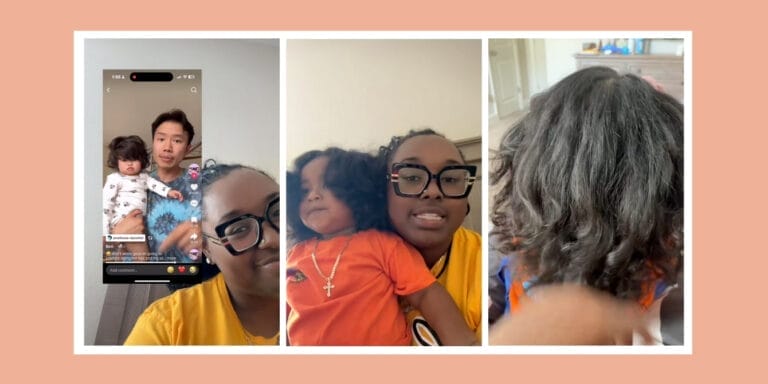Gentle parenting isn’t actually a new concept

Alison Winterroth/Stocksy
An expert dispels the myths around the latest trendy parenting style.

Table of Contents
Every few months, a new term describing some seemingly brand-new parenting trend or fad will bubble up among our Cooper members and cause them anxiety about whether they should—or shouldn’t—be engaging with the latest hot topic: baby-led weaning. Elimination communication. Lately, I’ve been having a lot of conversations about “gentle parenting.”
In our parenting groups on Cooper, a parent coaching platform, we frequently find parents aren’t sure what gentle parenting is, if they’re doing it—and if they are doing it, are they doing it correctly? I’ll break down the myths and share what to know.
What is gentle parenting?
Gentle parenting is an approach to raising children that prioritizes empathy, validation and respect in parent-child interactions. It emphasizes nurturing a strong, emotional connection with children, providing positive reinforcement and discipline rather than punishment.
What’s the problem with this? Nothing, really—except whenever a theory enters into the experience of everyday parenting, it becomes less simple.
Analysis paralysis
With gentle parenting, parents can be led to believe that gentle techniques mean their child will never be in distress, get angry or feel disappointment—and if they are, they’re “doing it wrong.” None of this is helpful or realistic.
The hyper-focus on your child’s feelings can have a paralyzing effect on parents. Think about it: You’re repeating “I know you feel sad” over and over—but getting no closer to getting your kiddo off the floor to get to school, or daycare, or swim lessons or wherever you need to be. Applying the most liberal interpretation of gentle parenting, a parent may then worry that they will do irreparable harm if they decide that this is the time they need to pick their toddler up and get to daycare, or hold a boundary or limit that causes distress.
Even if the intent behind gentle parenting is good, the pressure on parents to “parent the right way” is unprecedented. When gentle parenting is framed online and on social media as the “best” way to parent, it’s a recipe for guilt, shame and confusion.
Gentle parenting isn’t actually new
The idea of paying attention to and connecting with our children around their feelings is NOT a new one. Swinging away from harsher parenting styles of the last century (parents in the early 1900s were even told to touch and play with their babies as little as possible), a new emphasis on understanding and sensitively responding to children emerged. Adults who had been parented without sensitivity craved the connection that they felt lacked in their early experiences.
By 2011, Drs. Dan Siegel and Tina Payne Bryson famously encouraged parents to “connect before you redirect” in their (at the time, revolutionary) book, The Whole Brain Child. Citing the importance of our children’s inner worlds, Drs. Siegel and Payne Bryson suggested that parents should try to see behavior as communication, and seek the underlying cause of distress instead of getting stuck on the outward expression.
Where gentle parenting gets confusing
While gentle parenting (credited to British author Sarah Ockwell-Smith) supports the sensitivity and connection side of authoritative parenting, it is often used to justify languishing in a child’s feelings without the necessary guardrails and limits that research shows help children to regulate and organize themselves. It also does not honor the very real experience of parents in their own distress, dysregulated by their child’s highly reactive and frustrating behavior.
As a result, it often breeds feelings of shame and guilt when parents fail to maintain calm… not to mention a potential over-indulgence of a child’s feelings without encouraging them to move forward.
Try mixing in “authoritative parenting” techniques
Research has consistently found that authoritative parenting is linked to the most positive outcomes for children, including stronger academic and social emotional skills.
What is authoritative parenting? Psychologist Diana Baumrind identified four core parenting styles in the 1960s, and authoritative parenting includes:
- Highly demanding, but also warm and sensitive
- Clear expectations for their child’s behavior
- Openness to compromise and open dialogue with their child
At its core, authoritative parenting allows for sensitivity—and limits. It’s not all sensitivity all of the time.
Limits are essential
When done appropriately, limits provide children with a sense of safety and security through structure. This is not about enforcing limits with punishment, but about having guardrails that help your child to understand and learn behavior.
By setting limits, you show your child that you want to protect them, and that you are willing to tolerate their discomfort if it means they will benefit in the long run. Reasonable limits (like no throwing or adhering to a bedtime) help children to understand what behavior is acceptable. This allows them to regulate themselves to a “standard,” and toward clear expectations.
Being clear with limits and expectations can improve the parent-child relationship, as there are less periods of disconnect when everyone is on the same page.
Whatever you call it (or whatever it is being labeled on social media), practicing authoritative parenting is easier than you think. It’s an ever moving balance of limits and sensitivity—applied in real world situations. It’s not a perfect, therapist-syrupy voice you hear on every reel. It’s not parenting for the ‘gram—it’s a living, breathing, connection between you and your child that helps them to organize the world around them, and exist within it.
What this looks like in real life
Validating your child’s feelings does NOT mean you don’t also have limits. Acknowledge and name your child’s feelings one time. Then, move on. This may mean something like, “I know you’re having fun and you want to stay at the party, but we still need to go. Leaving is hard, but we can do hard things.” Then,
you can move your child’s attention away from the distress and onto the next activity. “Do you want to walk like a dinosaur to your stroller, or should I carry you?” And you’re out. They aren’t going for it and you yell? We all do! Repair. Say, “I’m sorry I raised my voice when I got upset. Sometimes that happens when I’m frustrated, but next time I’ll try and say it differently.”
For older children, you may say something like, “I understand how angry you feel that I won’t let you do that. It’s OK to be angry at me, but I’m not changing my mind. When you’re ready, I’m here to talk.” Remain present, remain available, but you don’t need to budge—because children need to see that we, as parents, can tolerate their distress and survive.
This story is a part of The Motherly Collective contributor network where we showcase the stories, experiences and advice from brands, writers and experts who want to share their perspective with our community. We believe that there is no single story of motherhood, and that every mother's journey is unique. By amplifying each mother's experience and offering expert-driven content, we can support, inform and inspire each other on this incredible journey. If you're interested in contributing to The Motherly Collective please click here.


































